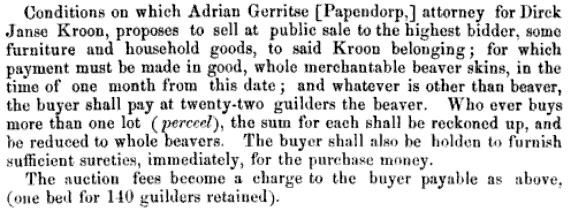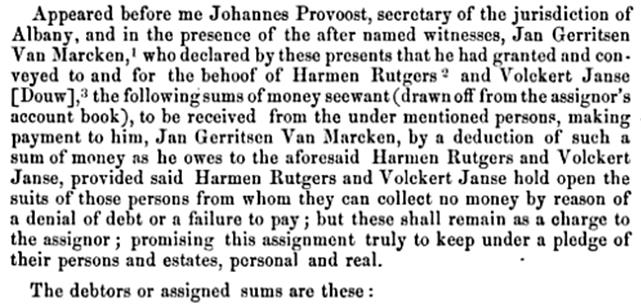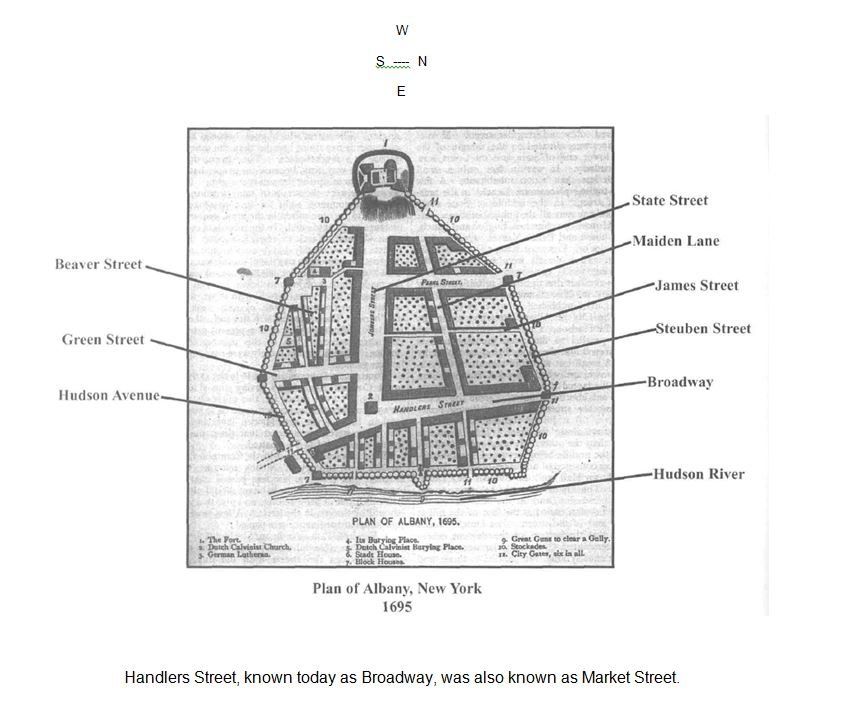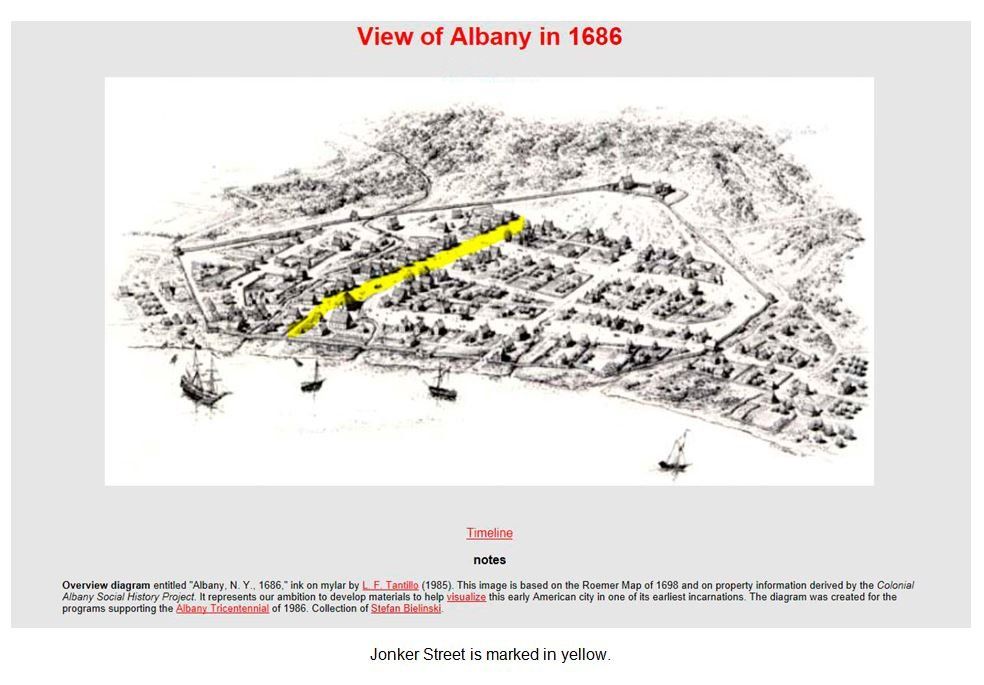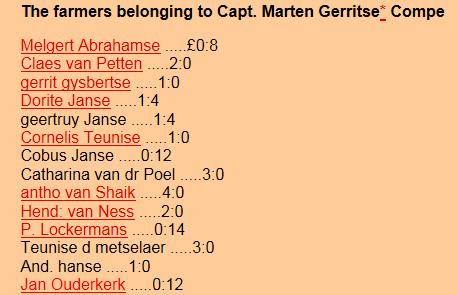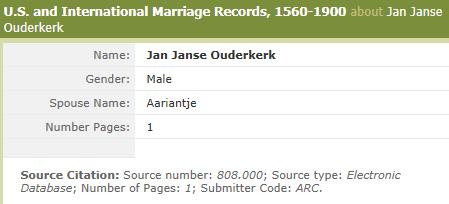Jan Janse Ouderkerk
Jan Janse Ouderkerk was my
seventh great grandfather. The following biography chronicles his life as an early settler in Albany, New York.
Tracing the life of an ancestor who was born more than 380 years ago is a daunting task. Translations of church and legal documents that were public record at the time have been used to provide evidence of our ancestor’s presence in what was then known as the New World. Jan Janse Ouderkerk emigrated from the Netherlands to the colony of New Netherland about 1656 and lived in Fort Orange/Beverwyck. At that time, Fort Orange was a small Dutch fur trading fort on the Hudson River. There is no certainty from where in the Netherlands Jan Janse came, but other family researchers seem to feel that the most likely origin was Ouderkerk aan de Amstel, a small town just outside the port of Amsterdam.
The following entry in the “Minutes of the Court of Fort Orange and Beverwyck 1652-1660” may well refer to "our" Jan Janse Ouderkerk, indicating he may have resided in the colony as early as 1656. The court date was in February of 1657, but it was unlikely that Jan had arrived in the New World during the winter months, so it seems safe to assume that he arrived sometime earlier. Jan Janssen, cooper, was being sued by Baefjen Pietersen. Jan did not appear before the court and so we don’t know the nature of the complaint.
In 1660, Jan Andriessen Kuyper, entered a complaint against Jan Jansen Ouderkerck (sic) but this case was also later dismissed by default.
Jan Andriessen Kuyper was likely a cooper (barrel maker) as the word kuyper/cuyper in Dutch means cooper. Whether he actually used the surname Kuyper is not really known. Some records refer to him simply as Jan Andriessen/Andriese. Jan Janse Ouderkerk was referred to as the 'small kuyper' or small cooper, indicating that there were at least two coopers in the colony in the 1660's. Coopers were very important as most everything that was stored or shipped was placed inside a barrel of some kind.
During the 1664 Second Dutch War, England seized possession of the colony of New Netherland from the Dutch and renamed it New York, for the Duke of York and Albany. The Duke of York and Albany later became King James II. Fort Orange and the town of Beverwyck were renamed Albany.
One of many challenges facing colonists was the acquisition of household goods. Most household goods would have been made by hand or acquired from estate sales and auctions. Jan bought three chairs at a public sale. Although the excerpt itself is not dated, the entries before and after it are dated May 1664, therefore indicating that this event likely took place in the same time frame.
On November 10, 1681, a fire destroyed seven buildings in the village of Albany, including Jan’s cooperage and the homes/businesses of his neighbours: Jeronimus Wendell, Jacob Tyse, Hendrik Rooseboom, Manus Borgerse, Pieter Davidtse Schuyler and Anthony Lespinard. This event was referred to as “The Great Albany Fire of 1681”. As the town likely contained fewer than a hundred structures at the time, this was indeed a significant event. The fire started in the shop of Jeronimus Wendell, the shoemaker, who had stored a quantity of bark for use in his tannery. As a result of this fire, a resolution was made on November 15, 1681, prohibiting the storing of shoemaker’s bark in town, prohibiting the burning of tar and pitch within the town and prohibiting the bringing of hay and straw into one’s house. The resolution also made provision for each district to have firefighting materials and for keurmeesters, or fire inspectors, to check that the town was following the laws regarding safety.
After the fire, Jan needed to either rebuild or find a new place for his cooper shop. It is unclear if he was actually living in the same location as the cooper shop as he had bought a house and lot up the street on a hill in 1679 as mentioned earlier in the section on deeds. On January 16, 1682, Teunis Pietersz/Pietersen sold to Jan Ouderkerck a house and lot Pietersz had bought from Harman Bastiaensz on January 6, 1681.
Jan was to pay 81 beaver skins for it and give to Pietersz the lot on which his house/cooper shop had burned as well as the round and square timber he owned in the woods. The next day, Jan asked Pietersz to release him from this deal. Apparently, he was denied and was then sued by Teunis Pietersz on March 7, 1682 for failing to go through with the deal. Jan’s defence was that he had been too drunk to recall the details of the sale. Witnesses confirmed that he was not sober at the time and the court annulled the transaction.
Several additional references have been found which chronicle Jan’s life as a colonist. In March of 1679, Jan Ouderkerk was found on a list of Albany householders as being responsible for the upkeep of two rods of the wooden stockade that surrounded the colony. In 1684, he was recorded as owing 2 Dutch guilders for his back taxes . Perhaps he had some difficulty re-establishing his livelihood after losing everything in the fire of 1681. Also in 1684, Jan appeared as a witness in a land dispute between Jan Spoor and Cornelis Thymes.
In the spring of 1689, the French and their Native American allies instigated raids against the colonies along the Mohawk and Hudson Rivers. This became known as King William’s War. On September 17, 1689, a group of residents met and formed an armed force to assist in guarding Albany County. Jan Ouderkerk was listed as a member of Captain Marten Gerritse's company. Jan was to receive payment from public revenues for his role.
What is surprising to me is that he was recorded as being a farmer, not a cooper. Had Jan become a farmer after his cooperage was destroyed in the fire or did he have to diversify to make a living? It is also interesting to note that the payments he was to receive were to be made in English pounds.
Susanna, Jan’s only daughter, married Cornelis Claas Van Den Bergh/Vandenburgh on December 13, 1693. They lived in the Westchester County area near Yonkers during the years between 1695 and 1700 and then moved on to Half Moon , New York. Cornelis Vandenburgh (sic) and his brothers-in-law, Isaac and Eldert Ouderkerk, were all recorded on a list of Freeholders in Half Moon in 1720.
To me, these both indicate that the men lived side by side and that Jan had moved on, leaving his property for his son, Isaac. I have found no documentation to suggest that the property was sold to Isaac, though that may have been the case. By 1709, Isaac was located in Kinderhook and by 1720 he was located in Half Moon.
Abraham lived in Canistagioene and married first, Lysbeth Clute/Elisabeth Cloet on January 6, 1706, and secondly, Ariaantje Van Nes on January 24, 1724. The marriage date of December 1, 1705, for Abraham and Elisabeth, as recorded by Jonathan Pearson, is not accurate in my opinion. As you can see from a translated copy of the original document, it appears to say the marriage was registered December 1, 1705, and they were married January 6, 1706. I don't really know what "Reg" means in this instance. It seems unlikely one would register a marriage before it had occurred so it may mean something similar to a marriage license, possibly instead of banns.


